Yamaha’s Tricity 155 is a cool little scooter from Yamaha, with sporty looks and an interesting dual front-wheel setup. Review by Kris Hodgson
So straight up the Tricity has sporty looks, with an aggressive front fairing and dual front wheel setup, that isn’t dissimilar to the Niken they announced at EICMA last year. I’m pretty sure I looked cooler riding the Tricity than the press shots of the rider in a white bodysuit on the Niken too. All my bodysuits were at the laundromats.
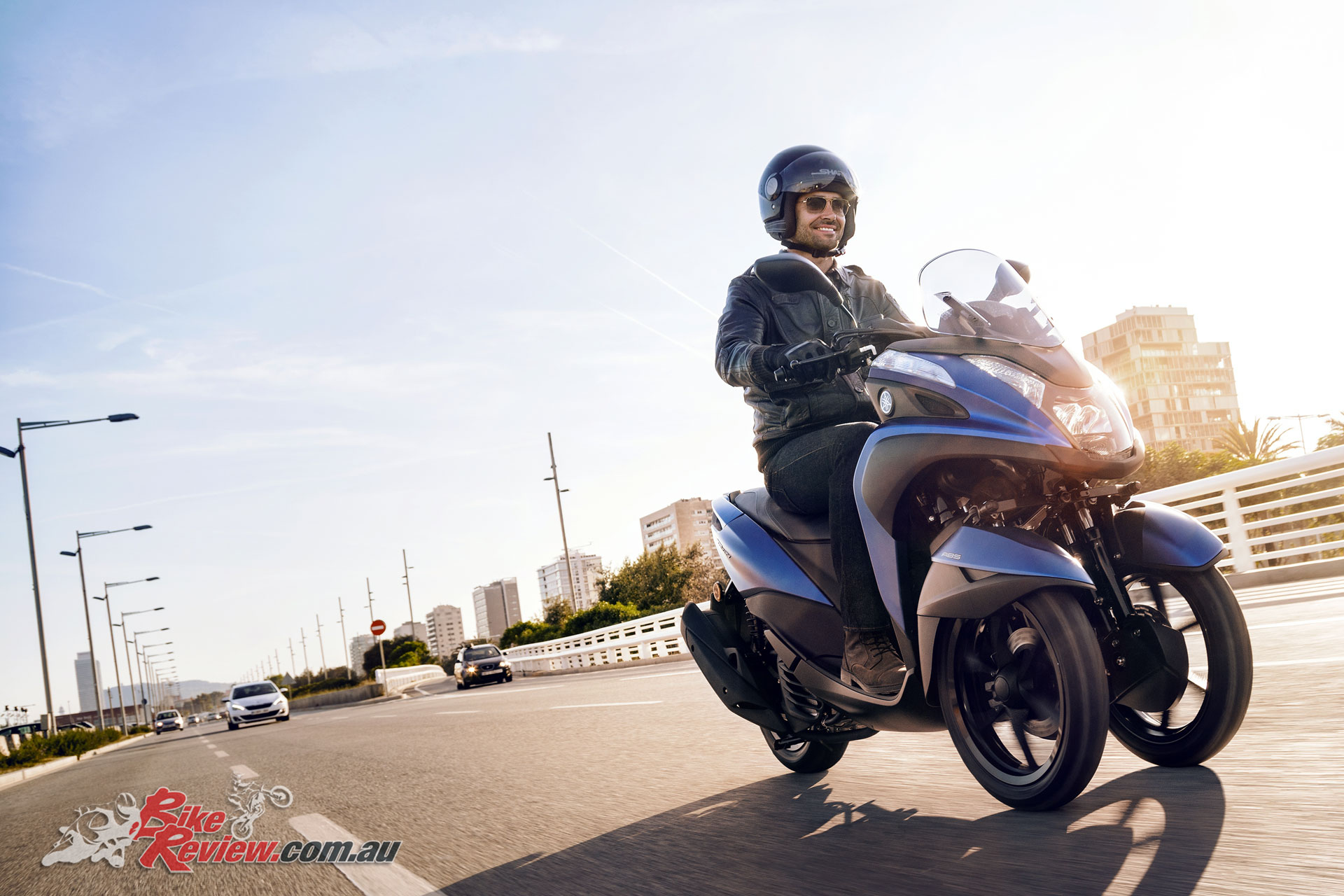
Yamaha’s 2018 Tricity 155 features the new 155cc Blue Core powerplant and a new frame. Pics taken with my selfy stick mid-corner didn’t turn out, so I’ve borrowed some from Yamaha Europe – Image courtesy of Yamaha Motor Europe
Powered by the company’s ‘Blue Core’ 155cc single-cylinder powerplant that is also found in the NMax (which is 50kg lighter), there’s punchy power on tap from throttle open to 50km/h and smooth fueling throughout the rev range. Fuel economy is also exceptional, as you’d expect, with an economy warning light on the dash which you’re meant to deactivate as much as possible, as I understood it.
Part of this comes down to Yamaha’s Variable Valve Actuation or VVA, which is used to offer different cam profiles at different rpm, meaning you don’t need to compromise performance for just one area, but can deliver an ideal low to mid rpm profile, and high rpm profile for example. This helps provide broader power, but also offers the benefit of significantly better fuel economy and emissions.
However you look at it, it’s an ideal powerplant for an urban commuter, and being an automatic makes for a convenient, stress free experience regardless of how heavy traffic is. That extra width at the front does somewhat limit your filtering, but it’s not extreme by any means and I think the extra stability will be a real boon for those looking at this option.
While I wouldn’t park the Tricity and expect the dual front wheels to keep it upright, they do offer a more planted and stable feel, which is ideal for those who may be lacking in confidence and need the convenience of a scooter or motorcycle for transport. Keeping in mind this is a learner legal option, it’s a great way of gently entering the two-wheeled world.
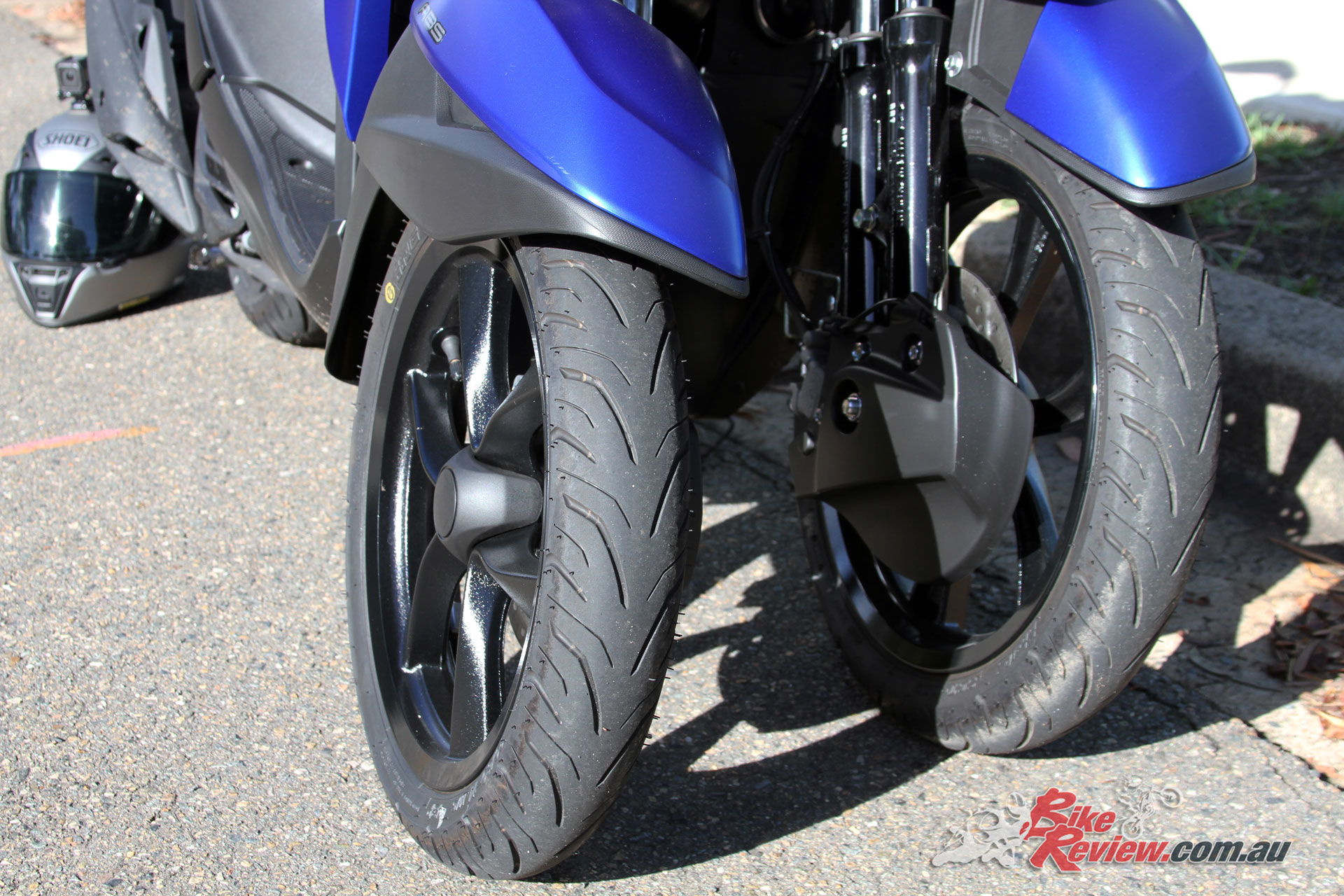
Dual front wheels are supported by dual forks on each side, with sporty 14in six-spoke wheels and a disc brake assembly on each
What kind of limitations does that front setup include? Well to be honest running out of ground clearance on roundabouts was more a testament to my carefree approach to suburban hooning, and is the same thing I’ve encountered on 250-300cc and scooters. Plenty of lean angle for this style of scooter is still possible, and apart from being able to feel the balancing system between the two sets of forks at times (when upright), it’s really little different than a regular scooter. Just more stable as mentioned.
The dual-dual fork setup is obviously there to handle the stresses caused by this kind of front end design, and probably the most noticeable issue this causes is a stiff front end – on the scooter – when going over speedbumps or onto driveways from the road. I could slow down… but no one likes a conformist.
So handling is scooter-like, and coming from a motorcycle you’ll need to use what seems like copious amounts of brake to control your excessive speed – if you ride like me, in an un-scooter-like manner – rather than being able to rely on a gearbox and engine braking.
The Tricity is well sorted in this regard, with a disc brake on each of the front wheels, mounted to the inside of the wheels, which are single-side mounted, as well as the usual rear disc brake system. Linking these systems together is the UBS or Universal Braking System, with ABS as standard fitment.
I first noticed the UBS when using the brakes, because if you’re holding one brake lever in (braking) and then apply the other, there’s a noticeable pressure drop in the opposite lever. This isn’t felt through the actual brakes themselves, just at the lever and is not that easily noticed. On the D’elight on the other hand, it is very noticeable, which highlighted what was going on. Overall brake performance is good, without being over the top, and it would be hard to catch yourself out unless you really misjudge your braking distances.
There’s no extensive electronics system, just the ABS, with a wide digital dash with two buttons at the top that allow switching through options, and resetting your trip meters. Simple. There’s also a hand brake on the left ‘bar for those difficult parking situations.
Now on to two very important scooter features, comfort and storage. The single-piece seat is released via the ignition, with a counter clockwise turn of the key releasing the seat. The seat itself is large, comfortable, and offers plenty of room to move around on. Doing some longer, probably less typical rides I remained comfortable, with the footwell area allowing a good amount of leg room and a pretty natural foot resting place, even with my massive motorcycle boots on.
A hook allows a bag to be hung between your legs, while a small glove box compartment includes an oldschool power outlet, meaning a mobile could be stored and charged in here as needed. As far as I could tell it doesn’t lock, so don’t leave anything valuable in here.
Lift the seat and you’ve got access to a very simple fuel tank cap, which you turn to release and is unattached, so don’t lose it. 7.2L of fuel capacity seems generous, with good mileage and cheap refills, making for an ideal inner city commuter for the budget minded.
The underseat storage will fit a regular helmet, and whatever you can stuff inside the helmet, so at the very least you won’t be lugging your lid around everywhere you go.
Now one note for the new Tricity 155 is the fact this is a vastly upgraded model over the old 125 version, which I never had the opportunity to test.
Straight up Yamaha are claiming better fuel economy, with the obvious power gains that adding 30cc makes on top of 125, plus of course the general advancements made in the last few years. The frame is all new too, while the headlight is LED, and storage is increased over the previous model.
The Tricity is produced by Thai Yamaha Motor, and the finish quality is a real strong point, with the matte ‘Cyber’ blue a real eye catcher. It’s a little messy with the front setup, but that’s hidden by the front fairing and wheel guards and isn’t something you’d normally notice.
Overall I was really impressed with the Tricity, it has the looks and the performance to make a commendable urban or city commuter, and really stands out from the crowd. 15hp is by no means breathtaking, but Yamaha deliver it in just the right way to ensure a fun experience.
The cool front-end setup is a departure from the norm, and I’d love to see a larger capacity version like a 300cc to take the concept to the next level, but as it stands I think it’s a commendable offering.
If you’re looking for a small capacity transport and don’t have your heart set on a motorcycle, check out the Tricity 155, it would be hard to find anything easier to get started riding on, and for a city runaround is a great option.
2018 Yamaha Tricity 155 ABS (LAMS) Specifications
Price: $5,099 + ORC
Warranty: One-year, unlimited kilometre
Colours: Cyber Blue, Oxford Grey
Claimed power: 11.1kW[14.8hp]@8000rpm
Claimed torque: 14.4Nm@6000rpm
Wet weight: 165kg
Fuel capacity: 7.2L
Engine: Liquid-cooled, four-stroke, SOHC, four-valve, 155cc, 58 x 58.7mm bore x stroke, 10.5:1 compression, EFI, TCI, V-Belt Automatic, Variable Valve Actuation (VVA)
Gearbox: Auto
Chassis: Backbone frame, Unit swingarm
Suspension: Dual telescopic forks, 90mm travel, dual rear shocks, 90mm travel
Brakes: ABS, Dual 220mm front rotors, single 230mm rear rotor, single-piston calipers
Wheels & Tyres: Alloy six-spoke wheels, 90/80 – 14, 130/70 – 13
Dimensions:
Wheelbase: 1350mm
Seat height: 780mm
Overall height: 1210mm
Overall width: 750mm
Instruments: Multifunction LCD display
2018 Yamaha Tricity 155 ABS (LAMS) Gallery
The Verdict | Review: 2018 Yamaha Tricity 155 ABS
Fun!
If you’re looking for a small capacity transport and don’t have your heart set on a motorcycle, check out the Tricity 155, it would be hard to find anything easier to get started riding on, and for a city runaround is a great option.


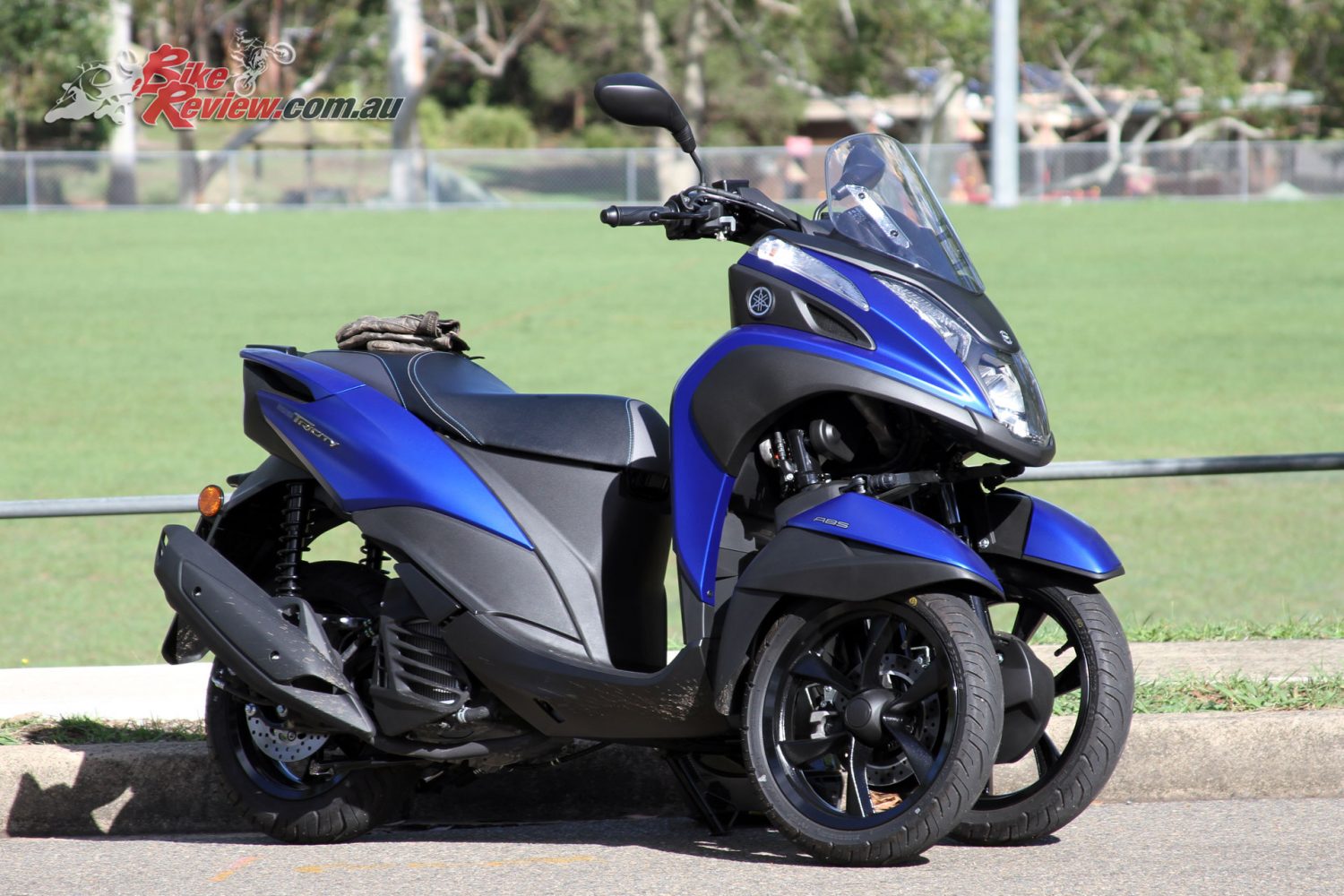

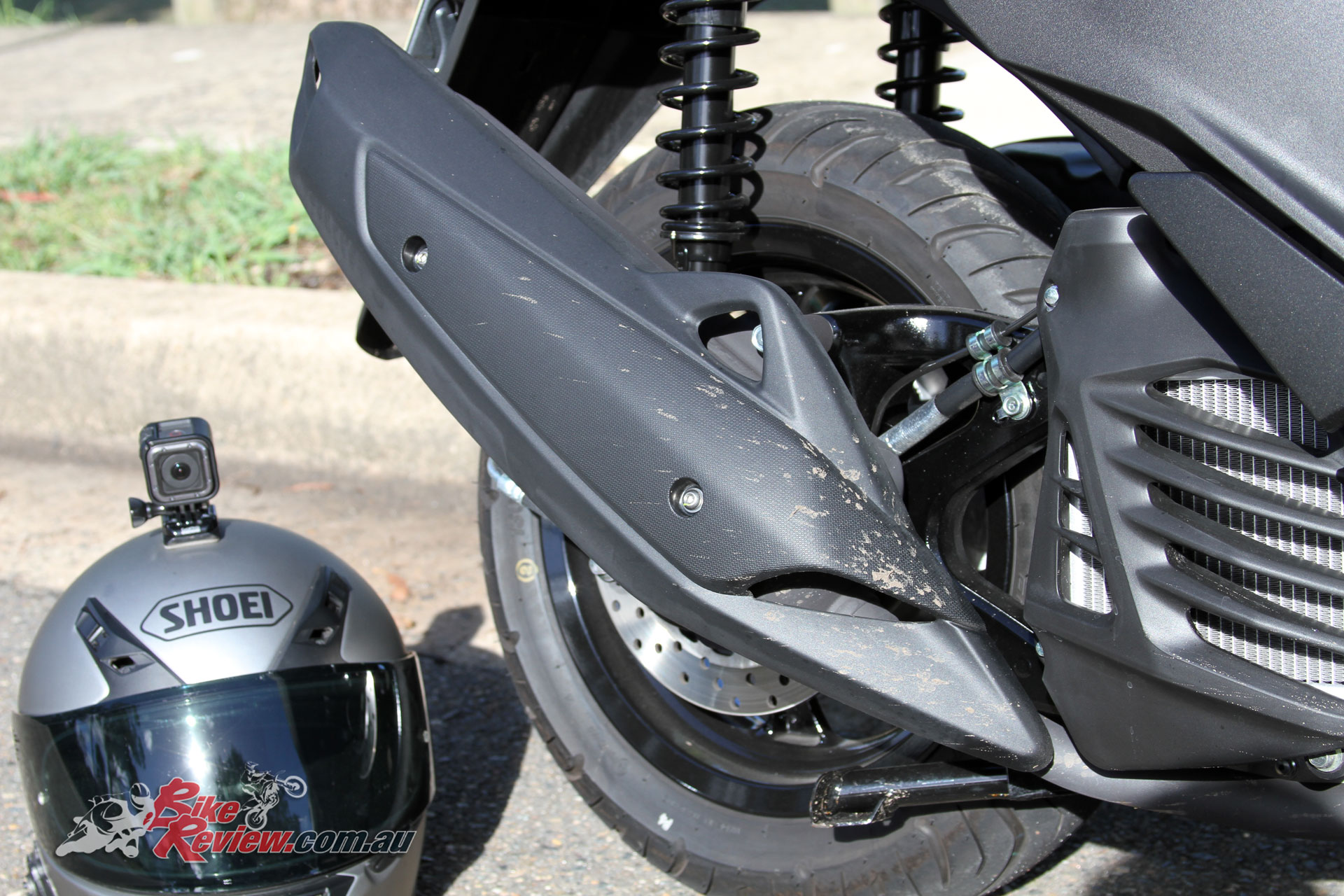
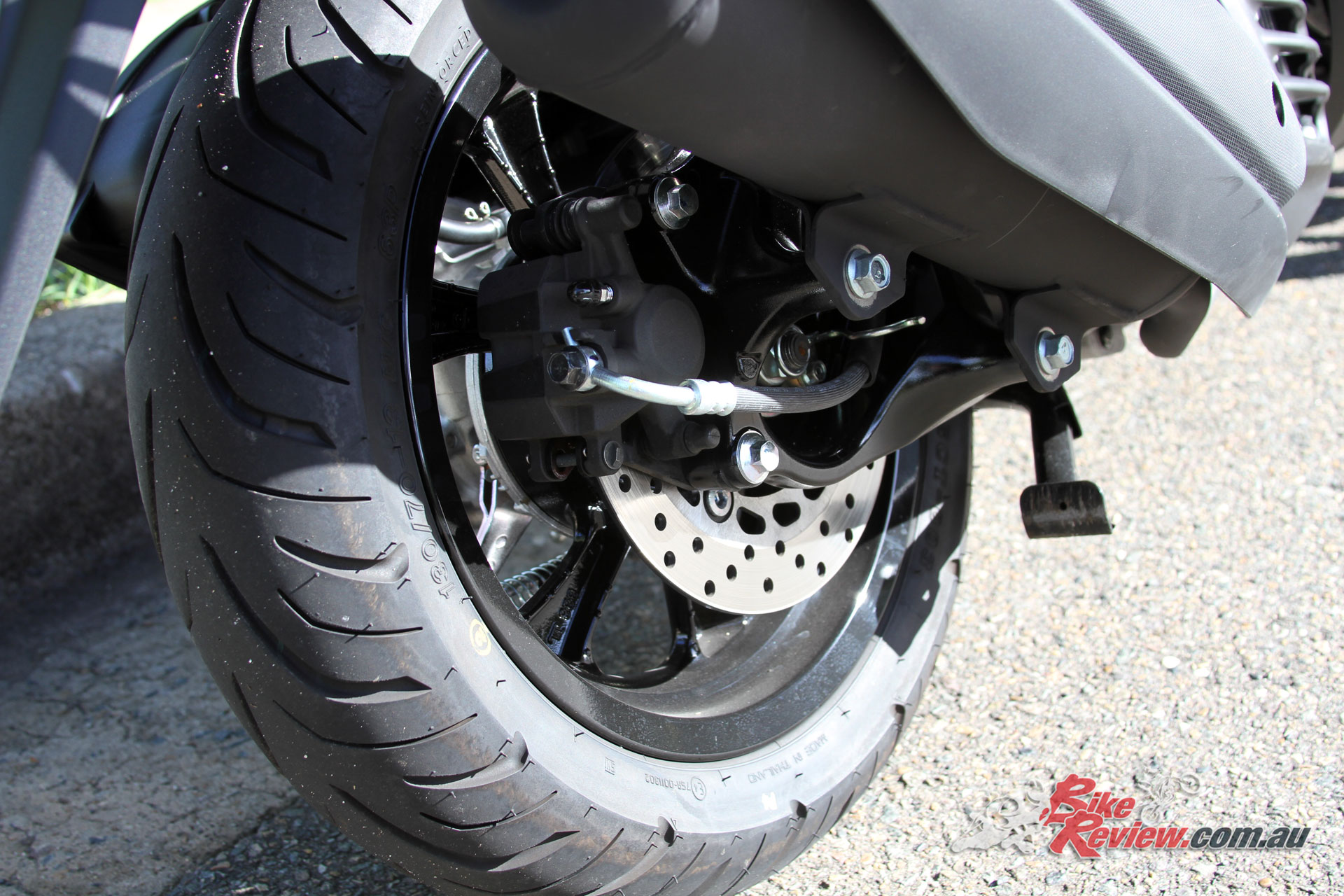
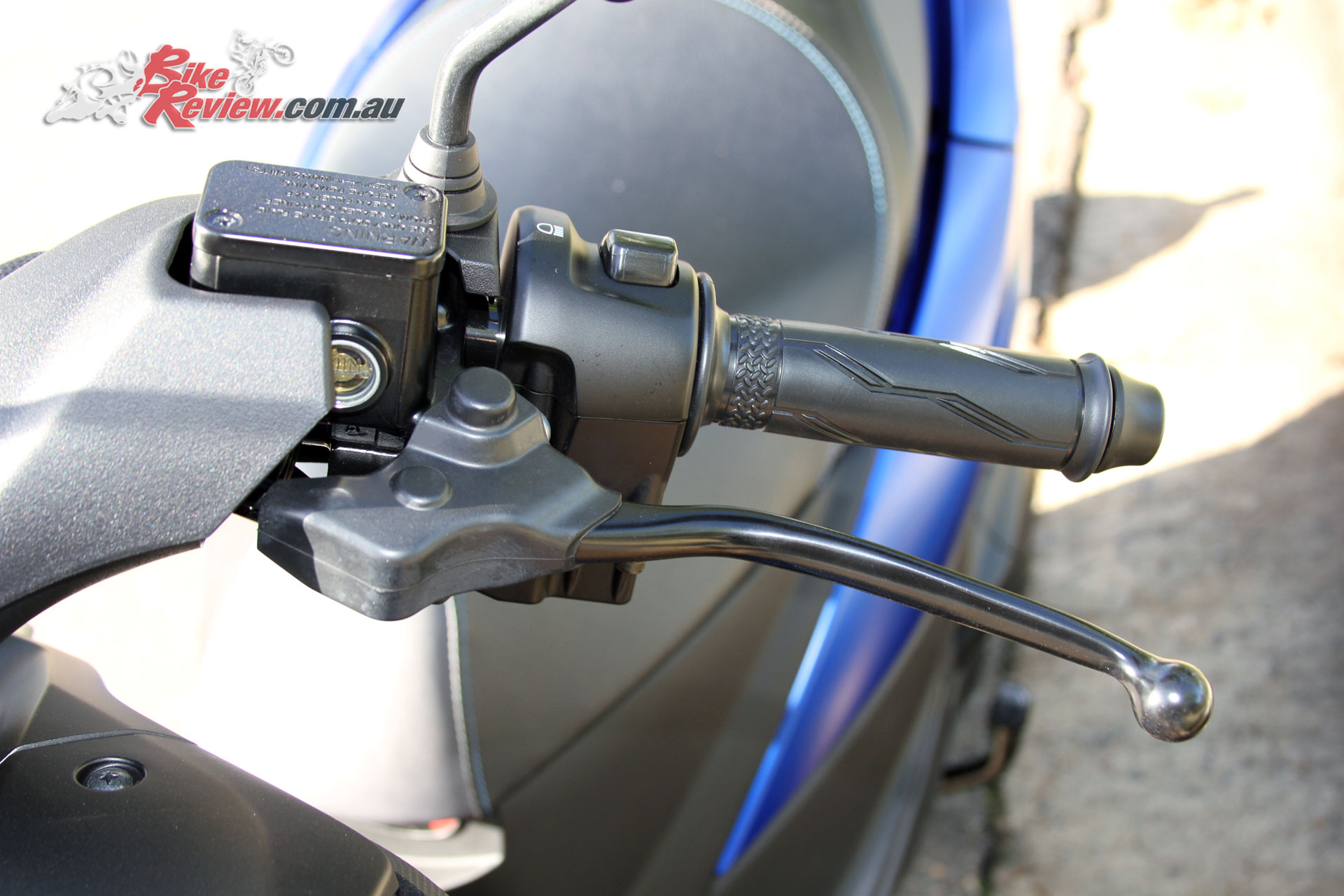

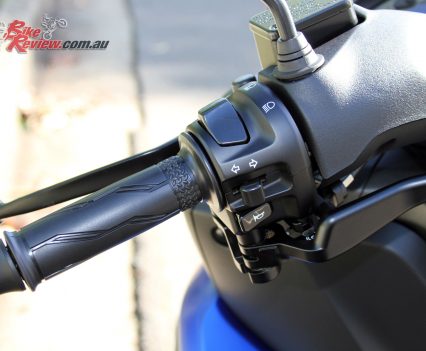
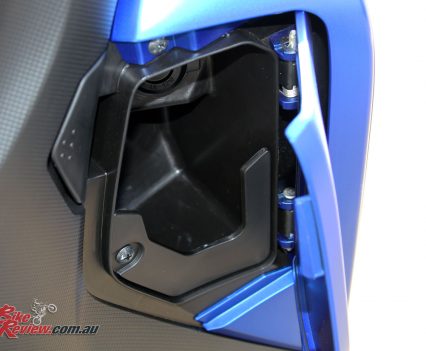
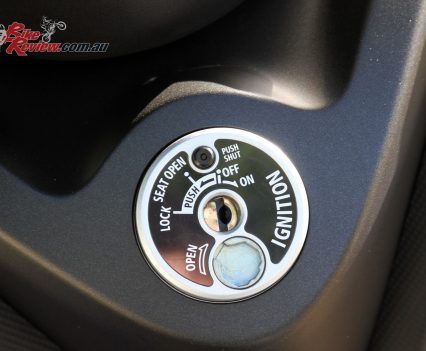

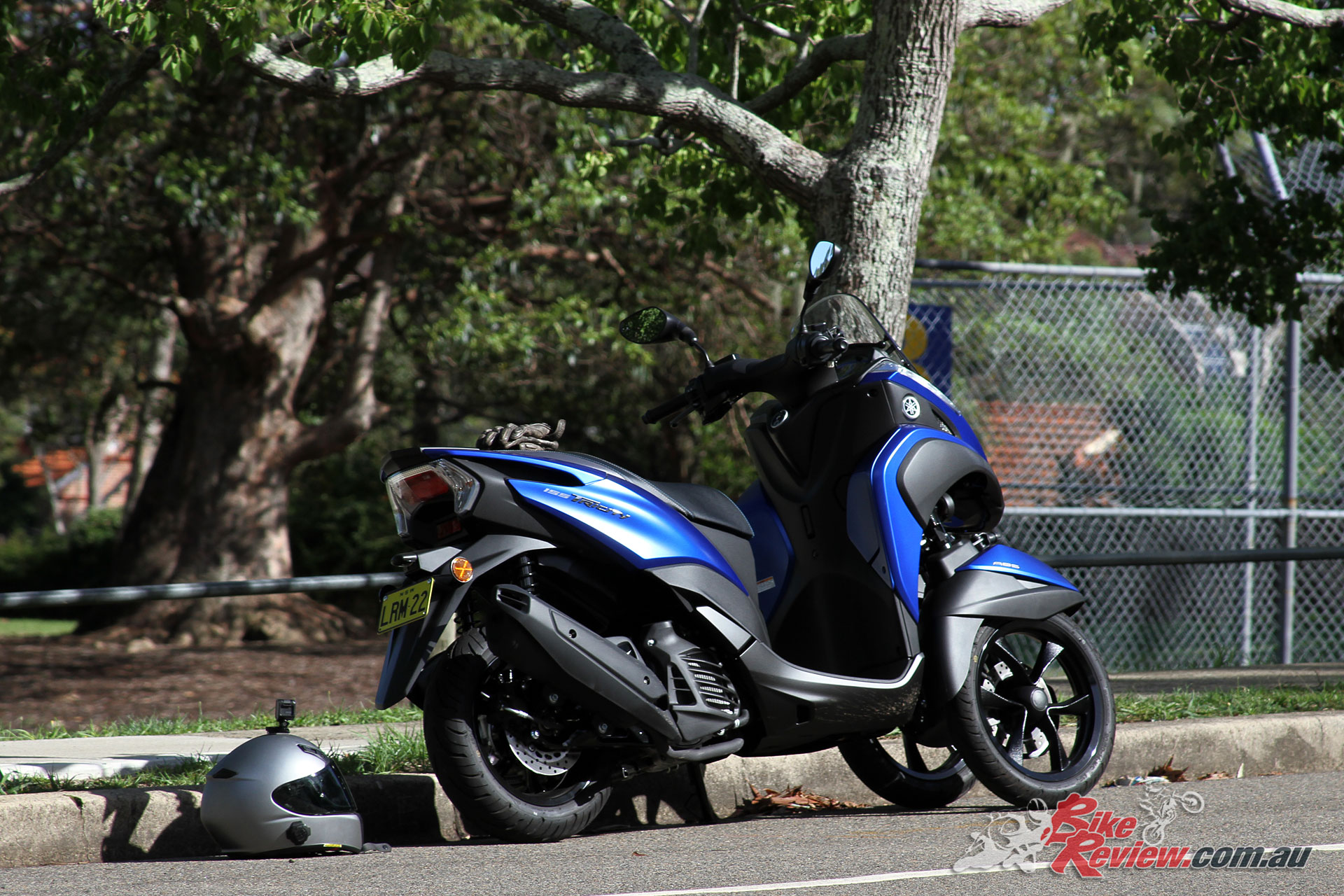





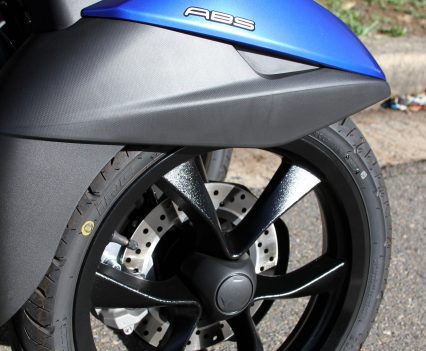
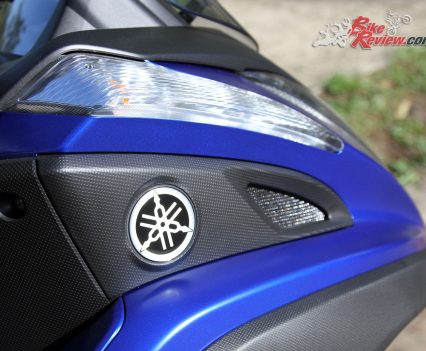


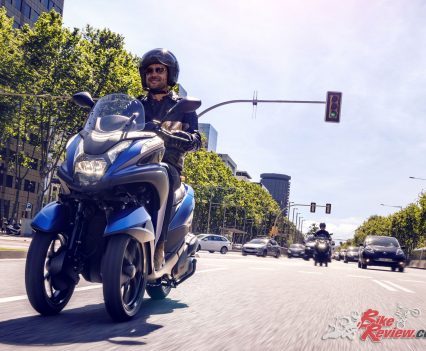
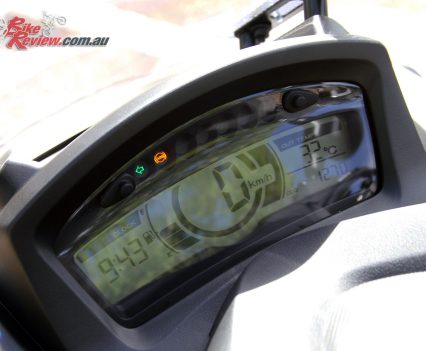
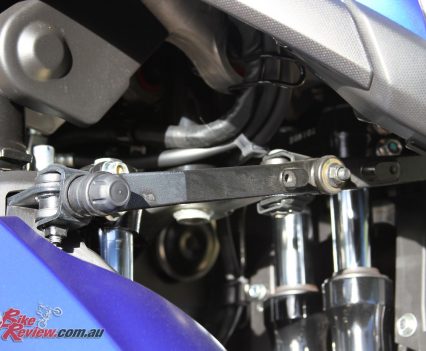
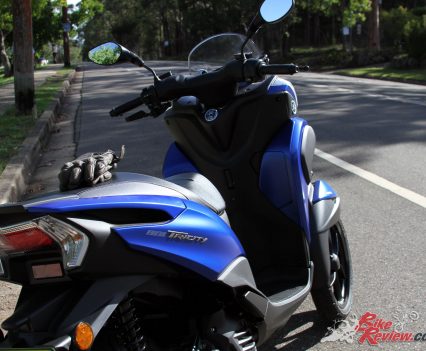
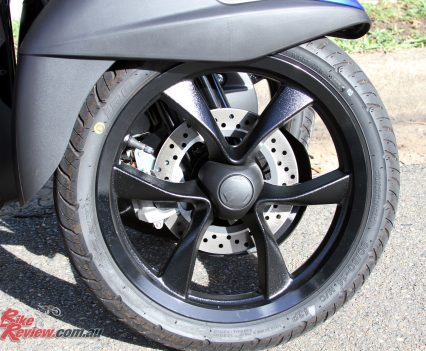

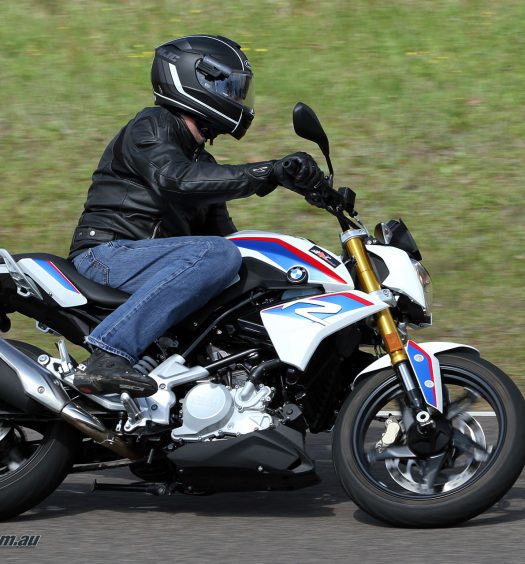


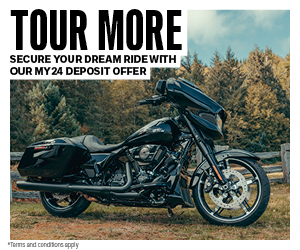

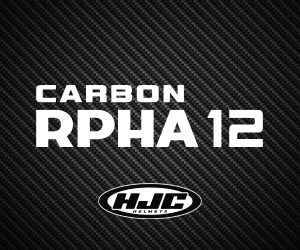
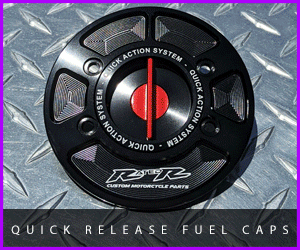
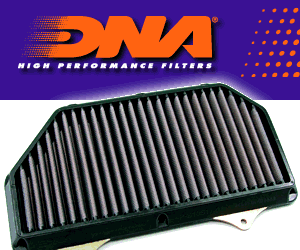
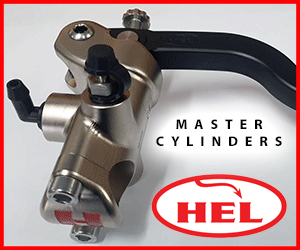







March 19, 2018
If you need 2 wheels on the front,
You should not be on a motorcycle period.
That nervousness is a sign your ability and make up is not suited
to bikes and you are taking a tremendous risk.
March 19, 2018
Hey Basil,
Kris here, and I can’t really agree with you there, but it’s a very complex issue. There are definitely people who shouldn’t be on two wheels (or even four if we are honest, but people rarely seem to mention that), and for motorcycles they’ll normally be picked up during the Pre-Learner course, or soon move back to four wheels, where they mainly endanger other road users from whichever ‘tank’ they settle on. With that said, being nervous about balancing and controlling up to 200kg of motorcycle – particularly around other road users – isn’t necessarily a bad thing and certainly better than an over-abundance of confidence, without the skills to match. It just doesn’t come as naturally to everyone, and there’s a huge amount of variables involved. Just a person’s proportions can have a huge impact for instance and picking the right machine is really paramount for your early riding.
Ideally things like driving experience and road/traffic reading skills really help when you start riding, but for some people that’s not an option. A scooter is a much more forgiving option and a great way of starting out. Someone who rode a bicycle for years as a kid for example may take to a motorcycle much quicker, but that’s not an indication that they will ever be a better rider, or even that they have the right attitude to keep them safe on our roads. It’s just a bit more practice, possibly easing the journey.
I think there’s also a rather big difference between scooter riders, and motorcyclists in most cases. Scooters are much more likely to attract people who just want cheap transport, and also far less likely to get the more sportily inclined beginners that gravitate towards a motorcycle and dangerous behaviour, because they are fast and cheap.
Also any time you get on a motorcycle you’re taking a tremendous risk, that applies to all riders, of all skill levels.
June 3, 2018
Hi Kris,
thanks for the review. Just a quick question – my daily commute is 30 mins thought Melbourne’s South East with nothing over 60km. Would you recommend this for me?
June 3, 2018
Hey Hank, definitely, the Tricity will handle cruising at 80km/h, so for a suburban commute at mainly 60km/h is ideal. You could consider the NMax, which is lighter, but in my opinion the benefits of being lighter are matched by the Tricity having three wheels which makes for good stability. It’s not much wider than the NMax either, so it’s still capable of filtering.
June 6, 2018
I have a Tricity. The two wheels are just awesome. 3 wheels and 3 disc brakes=the best braking bike I ever have ridden. This is a scooter, OK? But it rides more like a real motorcycle than any scooter I have ever ridden. Very nice in the curves. That 50:50 weight distribution is unlike any other scooter (scooters have mostly the weight in the rear). Tell me ANY bike that can take a curb at 45 degrees without jumping to the side? This can and its like gravy! It’s a scooter, OK? But it is a pleasure to ride and the extra wheel just adds more footprint on the road. It is not a “trike”so get over it!
June 17, 2018
From what I have read there is a new Yamaha 3 wheeler due out at the end of this year or the beginning of next year. It will have a different front end design than the Tricity/Niken. the new one will have a wider stance, with a larger engine but still for LAMS use and far sportier looking. I mean lets face it, all of these 3 wheels (all brands) look like mobility scooters for the elderly. Look at the 03-GEN-f concept, something alone those lines, it will still be automatic with a tilt lock. When they start to made these 3 wheels, look like bikes at the front end and scooters at the rear end, these vehicles will be very popular especially for those entering biking, returning to biking or as a second bike to go to work or run down the street to get a litre of milk.
July 1, 2018
Hank
I’ve had the 125 and now the 155. Both will get to 100kmh on the highway and I weigh 110kg. Being a small single cylinder they quickly drop 10kmh on slopes and in headwinds, but i’ve taken them over major NZ hill ranges at about 60kmh – but most corners are rated lower than that anyway. While capable of open road speeds, that is their limit so don’t expect to overtake much.
The 155 is much more responsive on take off up to 70kmh so is good fun around town. They are extremely manoeuverable, and with abs on three discs can outbrake any bike I’ve encountered on rider training courses. And you don’t have significant worries about white lines, manholes or the like as you nearly always have one wheel on solid ground (note that could be seen as a negative habit if considering going up to a more powerful two wheel bike). In heavy rain two wheels does add drag and takes your top speed down. That said the front shield provides great protection against said rain.
As for Basil, it’s not about capability, people are allowed to have fun. Not sure of your qualifications to dictate who drives what. You might feel superior on two wheels but I feel superior paying five times less for annual registration for my lowly three wheeler, and my insurance premium and excess is less than for an older cheaper motorcycle. In NZ you can also drive them on a car licence, which limits costs if you don’t want to get a $500 bike licence.
July 19, 2018
I purchased a 155 some months back. This is my 15th ride over 50 years, rides that go back to K1s, Z1000, RD 400, R100R etc. So why did I buy this ride? It just makes sense for my intended use. What I can say about this scooter, and it is a scooter, is that the longer you stay with it the greater is your appreciation for the many design aspects on offer. Grunty ponies up to 75-80kph (I only weight 68kg) and a generous flat floor for hauling shopping are valuable assets for a scooter. A lot of technology at a great price …. and fun to ride
August 26, 2018
Sir, i dont how to ride a bicycle. Can you recommend this for me? Does it still need balancing for me to drive it.. thanks.
August 27, 2018
Hey Lucky,
Having three wheels certainly helps with balance and makes for an easier learning experience. If you’ve never ridden a bicycle the Tricity may be a great place to start, but try any similar capacity scooter and see how you feel. Scooters have a nice low centre of gravity and are much easier to handle than a motorcycle, the Tricity just adds a lot more stability with the extra wheel.
September 11, 2018
Good review!
I have a 155 Tricity. It’s just great: economical; stable; grunty enough to keep up with traffic on the motorway and really fun to ride.
I thought one day I might “graduate” to the XMAX 300 but my preference now would be to purchase a Tricity 300 if Yamaha ever brought it out. I’m probably never going back to two wheels.
November 16, 2018
I have 3 Yamaha motorcycles. GT125 and Aerox155 both driven in Thailand, and Tricity 155 here in Sydney Australia.
Performance wise I feel that the Tricity is a small amount slower than the GT125.
The Tricity does not come close to the Aerox 155 or the Nmax 155.
Except for the lack of rear stand clearance around corners, the Tricity 155 has the nicest and non-twitchy handling of any bike I have driven.
For myself around the city I would purchase a Nmax 155 but this Tricity is for my wife to get her driving license on and for that purpose the Tricity 155 is probably one of the best learner scooters out there. If the Tricity 155 was actually a Tricity 200 then it would be more comfortable in the traffic as the 155 can only just accelerate at normal traffic speeds when 2 people are on it. I keep worrying about being run over by the cars behind me when taking off from lights. Single person driving is OK.
January 31, 2019
Kris, just booked to get bike licence birthday 55. Have great balance, surf rock reefs in Sydney and Gold Coast. Cant understand Basil’s comments. If you have ridden asia and bali in party mode scooters are for safe fun. Tried a Tricity last week …. getting one. More grip = can push it more. Dink wife, add surf board rack. Then if want upgrade once allowed …. the Niken
February 1, 2019
Nice stuff, that sounds like a great plan!
June 11, 2019
Why there is no measure of braking distance from 100 km/h (62 mph) to 0? This is important factor if one considers going into extra wheel. One extra wheel should work in advance when braking, for example 3-wheel Piaggio MP3 brakes within 30 meters (98.5 ft).
Another (silly) thing : why don’t You mention maximum speed? I can understand that some people might never make use of highway but… for another people it is important factor to know if 155cc will struggle on highway. And aside from max speed – what is the noise/vibration at max speed?
June 13, 2019
Hey Mathias, this definitely isn’t a highway machine 80-90km/h cruising should be do-able, while I wouldn’t ride this particular machine on a 110km/h freeway, and would only do a very short stretch on a 100km/h highway. We managed 110km/h on the NMax 155, which is considerably lighter, but even that was really pushing it. We’d never recommend a 155cc for highway use, 250cc is really the minimum for someone looking for that kind of use. For safety you need to be able to cruise at the speed limit (110km/h) with some additional performance for overtaking.
That kind of braking distance measurement isn’t something we’d usually look at for a scooter, however the Tricity performed well on the brakes, but obviously the extra weight counteracts the dual disk brakes to an extent and there’s additional stability thanks to the two wheels in slipper conditions. The Tricity 155 really benefits in being easier to brake hard in that regard.
June 13, 2019
Dear Bike Review
I must say that I am VERY dissapointed regarding no data about braking distance. When You buy a car You can usually find braking distance in reviews and You can judge if car is “enough safe”. In my opinion it is not good to ommit measuring braking distance in motorcycles. Braking distance should be a mandatory test.
For long time I had no idea that…
…. chopper motorcycles brake better than sport bikes! This is something worth knowing and understanding physics behind it is interesting. I could not belive at first sight but there are two factors influencing braking distance of 2-wheel motorcycles:
– more inclined head angle means less tendention of motorcycle to get rear wheel into the air (limiting factor even for motorcycles equipped with ABS)
– wider (than usual) front tire means more grip
This is silly that company introducing 3-wheel motorcycle does not care to give data sheet with braking distance. All tests of Tricity or Niken ommit measuring braking distance. This is weird. It can mean that chopper motorcycles still brake better.
Please consider including testing braking distance in Your tests.
Cheers!
June 13, 2019
Hey Mathias,
That may be a manufacturer provided figure unless they are independently tested, and while it’s a nice point of comparison on paper, on a motorcycle there’s a lot more rider skill involved in coming to a stop as fast as possible even with the widespread adoption of ABS. For independent testing that would require a closed circuit, similar conditions and testing methods to ensure valid figures, which is a very large expense for a small publication. In the real world there’s huge variance once you add tyres, brake pads, condition/upkeep of the overall braking system, the rider and each braking circumstance. There’d also be legal issues these days with all the litigation, with manufacturers trying to claim stopping distances I would bet.
I’m not sure what you mean by choppers braking ‘better’ than sportsbikes, choppers are generally significantly heavier and a much higher proportion of braking is undertaken by the rear compared to a sportsbike due to the weight distribution, while most cruisers don’t have braking systems that will match a sportsbike. There’s a huge number of factors working against choppers in this scenario. So while the likelihood of lifting the rear is low on a chopper, the force transfer into the front tyre is very different, in that it just doesn’t happen the same way/to the same extent as there’s much less braking force on the front in the majority of cases. On a sportsbike the braking forces that lift the rear are also the same forces which maximise the front contact patch. I’d take a sportsbike any day if I needed the shortest stopping distance, with better brakes, better tyres, a better weight distribution for braking (plus lighter machine), and most likely better ABS technology due to all the racing applications it’s derived from.
On paper some of the figures thrown around about the Niken are 40% more front grip, and 20% shorter stopping distances (to an undefined motorcycle). I can’t find anything to substantiate these, but it’s also a significantly heavier machine. A key part of safe riding, or driving is also always going to be knowing the limitations of your vehicle, which incorporates braking distances, which is something you learn, if you practice emergency braking, or do advanced training courses. It’s a compromise all drivers make too, regardless of whether they picked a car with a slightly better stopping distance in professional hands in a controlled environment.
We do normally try to cover braking performance however. I hope that makes sense!
June 14, 2019
Braking distance with factory settings:
Superbikes:
2011 BMW S1000RR: 129 ft
2011 Ducati 1198: 141 ft
2011 Honda CBR1000RR: 134 ft
2011 Suzuki GSXR-1000: 140 ft
2011 KTM RC8R: 135 ft
2011 Kawasaki ZX10R: 129 ft
2011 Yamaha R1: 137 ft
Supersports:
2011 Yamaha R6: 124 ft
2011 Honda CBR600RR: 126 ft
2011 Ducati 848 EVO: 127 ft
2011 Triumph 675R: 126 ft
2011 Suzuki GSXR-600: 122 ft
Other bikes:
2015 Harley Street 750: 152 ft
2011 Harley StreetGlide: 129 ft
2011 Star Stratoliner: 142 ft
2011 Kawasaki Vulcan Vaquero: 144 ft
2013 BMW R1200-RTP: 144 ft
2013 Harley Electra Glide: 144 ft
2010 Star Raider S: 124 ft
2010 Harley Softail Rocker C: 125 ft
2010 Victory Vegas Jackpot: 129 ft
2006 Piaggo MP3 98.5 ft
Please note that superbikes and supersports have:
– steel braided brake lines
– metallic brake pads
– monoblock calipers (pressure won’t expand caliper as much as with regular calipers)
– large brake rotors
– good brake pumps
– expensive (sticky) tires
… while scooters and choppers have:
– rubber brake lines
– resin brake pads
– casual brake pumps
– casual tires
– etc..
When You understand physics behind braking You will note that arrangement of wheels works in advance for 3-wheel (2 wheels front) motorcycles and more inclined head angle means means less tendention of motorcycle to get rear wheel into the air (ABS has got less work, You don’t loose traction as with steep head angle – try to make stoppie on Harley and on superbike). When I buy (2-wheel) scooters I always replace brake lines into steel braided ones, I change brakepads to metallic ones and braking performance is much better. But I still know that adding extra wheel in front does miracles, there is nothing that brakes in motorcycle world as efficient as Piaggo MP3 (I don’t own MP3 – it’s too heavy in my opinion, Piaggio resisted to make light 3-wheeler for long time so I ommit Piaggo).
Technical siednote: there is risk that tilting mechanism will faster develop play (worn bushings, worn bearings) under heavy braking and manufacturer might chose smaller rotors, not so efficient calipers, no steel braided hoses, etc to keep longevity of the complicated front 2-wheel tilting mechanism. This has to be taken into consideration if one replaces elements by himself (brake pump, brakepads, steel braided lines). I asked for braking distance of Niken and one guy said that on dry asphalt Niken brakes within 40 meters (131 ft). There is great use of extra wheels in the corners (more stability) but braking distance isn’t brilliant to put it politely.
In my opinion You should insist that motorcycle manufacturer arranges brake-testing equipment during the day. Try to make initiative move. I see no reason to buy 3-wheel scooter/ motorcycle if braking performance is unknown.
June 23, 2019
Firstly, let me complement you Kris on a very informative, competent review and response to reader’s comment. I, like Mark who commented in July 2019, am a seasoned motorcyclist of some 46 yrs, having owned Ducatis, Guzzis, BMW’s, Triumphs, Buells and Harleys amongst the 19 I have owned. I have never been attracted by scooters, much preferring the looks and dynamics of a motorcycle. However, I am now serious considering a Tricity to enable me to cope with the challenging road surfaces here in urban and rural Greece. Away from motorways, asphalt here is highly polished with unpredictable cambers, sometimes covered in gravel especially on tight corners. Despite experimenting with different tyres (I found Metzeler the best), cornering with confidence is well-nigh impossible on such roads and although rewarding to reach a destination unscathed its become unenjoyable on a larger type machine. I am impressed by the Tricity as it would appear to be a solution to my issue with grip here and in a way am rather attracted to it by its quirky looks and imaginative technology. Combined with a lowish CofG it could prove easier for me to handle these days despite not having a locking mechanism on the steering like an MP3. Can I please ask, how does the 155 cope with short, steep uphill gradients and tight bends especially as it’s an automatic? It sounds quite manoeuvrable and easy to handle but as it’s some 165kg wet is this going to be a drawback for 1.64m 65kg rider like myself who doesn’t live in an unban or city environment? Uses are 15km commutes to work locations, 35km trips into the large, busy main town in this region, and occasional ride-outs with friends on low speed tours of the area of about 150-
300km. Your input would be appreciated as no test rides available here… thanks…
June 24, 2019
Hey Petros,
Glad to be of help! One-up I didn’t have any problems even on steep inclines or sporty riding, although you do use a bit more throttle than a motorcycle to get the desired results, and the additional weight over the NMax 155 is noticeable in that comparison. You do change your riding habits without the ability to manually control your gears, but generally speaking that means a little more braking into corners and managing your speed – but then unless you’re trying to ride a scooter like a sportsbike that’s not an issue. I’m a little heavier and taller than you, and didn’t really notice the weight of the scooter itself except when I was really demanding maximum performance and it’s a bit slower off the mark – again in comparison to the NMax, but the engine picks up speed and revs easily.
As long as you’re not expecting to cruise at 100 or 110km/h for long distance is should be well suited to your needs, and low speed tours should be easy and comfortable.
June 24, 2019
Hi Petros.
I have owned my Tricity 155 for 15 months. This scooter started to ‘soften’ and feel liberated from about 2600 ks. Since the first release of the 155 in Sept. 16 (Europe) the only very recent change is a redesigned and lower seat platform at 165 from 180. This speaks well of the scooter. I am a perennial purveyor of most two wheel machinery, but any anticipated change of this machine will be a move across to a newly released white (in Aus.)155, which was always my first choice. This will happen before any need for tire change or first valve clearance check at 12,000 ks. The Tricity 155 ticks a lot of boxes for me. Mark — happiness is: Tricity 155 — Honda Monkey 125
June 28, 2019
… correction: that should have read at 765 down from 180 (for revised seat height) – Mark
July 6, 2019
I own a 155 Tricity for 6 months and have put nearly 8,000 km on it. As a commuter its a great wee machine.
My commute involves 5km of motorway which is never a problem for it. While it will do 120km/hr on the speedo (about 115 GPS), the reality is that it is a 155cc machine and its happiest at any speed up to 90 km/hr for extended running. Real world fuel economy is about 2.3 litres per 100 km urban, 2.5 litres per 100 km open road at 80ish and 4 litres per 100 km if you open the throttle to the stop and leave it there.
I toured with mine around the East Cape of the North Island from Wellington (about 2,000 km in three days) and it was just fine as I purposely avoided motorways and tried to ride the B roads where I could.
the only (recommended mod) is get a proper screen for it – the one that comes with it is useless.
I’m not sure what Mathia’s is on about. The theoretical braking distance of any bikes is as much about the rider as it is about the brakes. I can say that the brakes on the Tricity are very good for its purpose. It out brakes anything else that I’ve ridden.
I’m crossing my fingers that they make a 300cc. A little more power and longer legs on the open road would be great.
July 12, 2019
Hi Phil,
Always awesome to hear from an owner. We only get to test for a week or two and aside from our full long term bikes, it is hard to find out the real experiences of living with a bike or scooter. I reckon the TriCity is a ripper and yep an XMAX300 version would be a great scoot.
Good tip on the screen. Top stuff going touring! Sounds like a blast. Jeff.
December 26, 2020
I am looking to buy yamaha tricity for uber eats delivery. This means i will be driving all day around the city. I am new in driving. Will you recommend yamaha tricity for delivery purpose
October 19, 2023
I live in Auckland and bought a 2023 Yamaha Tricity with 125km’s on it in Christchurch. I flew to Christchurch and rode it the nearly 1,200 km’s back. I am in my 60’s and have owner over 50 motorcycles in my lifetime from super bikes to dirt bikes to scooters. A big influencer for purchase was the $110 per year registration for the Tricity, but after riding it 1,200km’s I have MUCH more good to say about it. A skilled rider can corner faster and safer in the rain, and it holds the road like a mid-sized motorcycle rather than a scooter. Heavy, yes, but perfectly balanced. I cruised at an average of 102kph during the trip and fuel economy was only 30km per liter due to wide open riding. Very quiet and torquey motor is only doing around 4,000rpm, so not like it is spitting its guts out to do 100kph. I saw an indicated 119kph on a downhill and I could not make it go 120kph, so perhaps there is a governor after a certain rpm? Absolutely brilliant machine and a work of art if you view it from an engineer’s perspective. Thank you Yamaha!
January 6, 2024
Hi Edward – I love to hear these stories! I had a De’Light for most of last year and did some long rides, it was fine! I really like the TriCity and I reckon the fuel economy is hard to beat, plus the big bike feel and the unique experience. Sounds like you certainly ran it in well. What an awesome start to the ownership. How is the bike going now? Jeff Ware